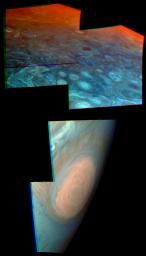These two views of Jupiter obtained by the imaging system aboard the Galileo spacecraft show evidence of strikingly different stratospheric hazes between the polar regions and low or mid latitudes. The Great Red Spot shows in one mosaic, centered at about 20 degrees South latitude and taken on June 26, 1996 at a range of 1.46 million kilometers. The other mosaic is centered near 50 degrees North latitude, and was taken on November 4, 1996 at a range of 1.60 million kilometers.
North is at the top in both images. In the Red Spot image, the edge of the planet (limb) runs in a single arc from lower left to upper right, with dark space at lower right. In the polar image, the limb runs in two segments across the top right corner, with dark space at top right. Both images are mosaics; the offset of the individual frames of the mosaic produces the jagged border and the break in the polar limb.
These are false color images, constructed specifically to reveal cloud elevation differences. Three color channels are used. The red channel is an image taken at a near infrared wavelength where methane in Jupiter's atmosphere is strongly absorbing, and therefore gives no information about deep clouds but reveals high clouds. The green channel is a weaker methane band, and the blue channel is assigned to a wavelength where Jupiter's atmosphere is transparent. Thus red features indicate high hazes. A view near the edge of the planet accentuates the high hazes because of the slanting path of the line of sight.
The pronounced reddening near the edge of the planet in polar regions indicates a high stratospheric haze. Comparison with the Great Red Spot shows that such a high haze is absent at that latitude. Detailed analysis shows that a stratospheric haze exists at both latitudes but is approximately 50 km higher near the poles. It is likely that the high polar haze is produced by magnetospheric particles, which travel along magnetic field lines and bombard the upper atmosphere in polar regions. The low and mid latitude stratospheric haze are likely caused instead by photochemical reactions.
The Galileo mission is managed by the Jet Propulsion Laboratory for NASA's Office of Space Science, Washington, D.C.
This image and other images and data received from Galileo are posted on the Galileo mission home page on the World Wide Web at http://galileo.jpl.nasa.gov. Background information and educational context for the images can be found at http://www.jpl.nasa.gov/galileo/sepo.

 Planetary Data System
Planetary Data System












